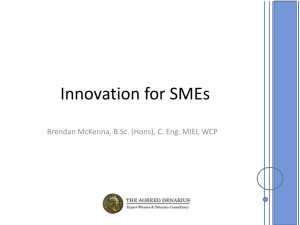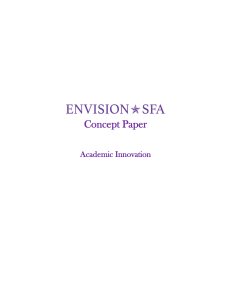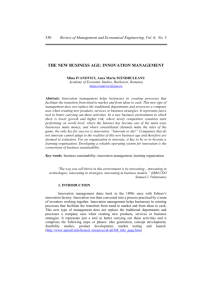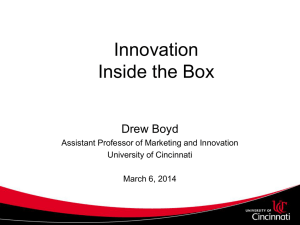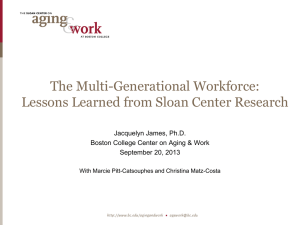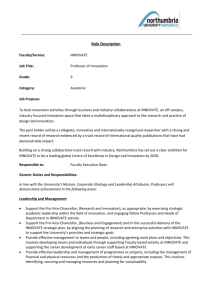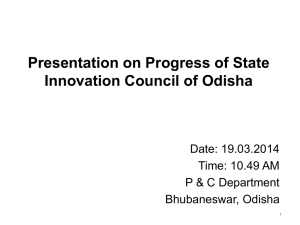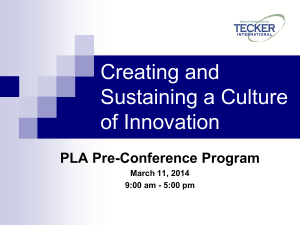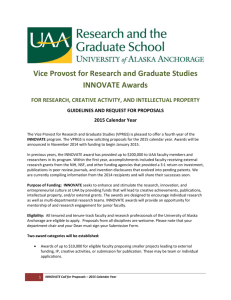Schools of Innovation 2014-2015 Leader Presentation
advertisement
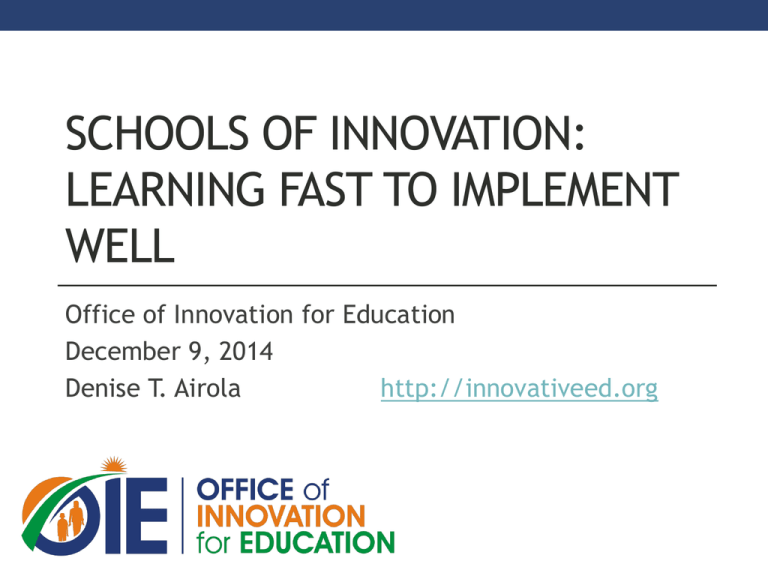
SCHOOLS OF INNOVATION: LEARNING FAST TO IMPLEMENT WELL Office of Innovation for Education December 9, 2014 Denise T. Airola http://innovativeed.org Schools of Innovation: Balancing Tension with Opportunity Change— innovation efforts Accountability for outcomes Improving teaching and learning Mission of the Office of Innovation for Education Change requires individuals and groups to trust and to risk. Our mission is to be partners with you in the process—to help minimize the risk and maximize the benefits to students, educators, and communities. It’s natural to be attached to memories of simpler times in education…even as we expect that change must come. Often, what is not expected are the pace, magnitude and multi-dimensionality of change. • https://www.youtube.com/watch?v=1gK5MWQ__Ns Innovation doesn’t mean you abandon what is working or what fits your community! Where do you start? Logistics: timing and requirements. • Commissioner’s Memo 15-039 posted 11-18-14 • Technical Assistance PPT http://www.arkansased.org/divisions/learningservices/schools-of-innovation • January 30, 2015 submit to ADE for review and feedback • March 16, 2015 final applications due. • Don’t forget course approval deadlines! Form Your Council of Innovation: Don’t try to go it alone! • Generate innovative ideas and proposals of its own; • Determine a method for requesting innovative ideas and proposals from school employees, community members, and other stakeholders to be submitted to the council; • Survey, focus groups, informal interviews (one-legged) • Receive innovative ideas and proposals from school employees, community members, and other stakeholders; • Consider all innovative ideas and proposals submitted by community members and other stakeholders; and • Determine the content and format of the plan that will be voted on by the eligible employees. Act 601 Focus Beyond Compliance Establish a Shared Definition of “Innovation” • Means leveraging new or unproven methods or tools to improve practice or solve persistent Problems; • Includes identifying tools or practices from another field to be applied in a new context; • Often represents an entirely new way of Thinking; • Has no rules: There is no “right” or “wrong” way to innovate; and, • Always forces important choices and trade-offs. Duty & Kern, 2014, So You Think You Want to Innovate? http://www.2revolutions.net/news/2Rev-TLA_Assessing_Culture_of_Innovation.pdf Duty & Kern, 2014, So You Think You Want to Innovate? http://www.2revolutions.net/news/2Rev-TLA_Assessing_Culture_of_Innovation.pdf Seven Factors Driving Innovation Duty & Kern, 2014, So You Think You Want to Innovate? http://www.2revolutions.net/news/2Rev-TLA_Assessing_Culture_of_Innovation.pdf Duty & Kern, 2014, So You Think You Want to Innovate? http://www.2revolutions.net/news/2Rev-TLA_Assessing_Culture_of_Innovation.pdf Getting the Right Fit is Key to Success Early innovators’ lessons learned: 1. Figure out what, or whose, needs you are trying to meet with the innovation. 2. Figure out your innovative learning solution before you select your technology. 3. Consider student fit, teacher fit and leader fit—one size does not fit all! 4. Monitor and measure your efforts and results. For more details go to: http://www.innovativeed.org/getting-right-fit-key-successfulinnovation/ How do you feel about the opportunity? Design? Dream? Dread? Schools of Innovation Source: 2revolutions Future of Learning available at http://www.2revolutions.net/index.html Innovative Design Parameters: Anchor Design in Core Principles Source: 2revolutions Future of Learning available at http://www.2revolutions.net/index.html Levers for Building: Key categories for innovating learning models Source: 2revolutions Future of Learning available at http://www.2revolutions.net/index.html How might you innovate to allow for more overlap among these program sectors to expand learning opportunities? Source: 2revolutions Future of Learning available at http://www.2revolutions.net/index.html *Ackoff on Improving Systems • Performance of the system depends on how the parts fit in the system, not on the parts individually. • Improve the parts only to improve the whole. • Improvement must be directed at what you want—not at what you don’t want. • “What could you do right now if you could do whatever you want?” The constraints are introduced later! • What are the parts of your system and how well are they working together? What could you do to improve the system? *Shared in training ADE training PPT for SOI Where should you focus your innovation? • Start by understanding your system. • Use your data to understand what is working and not working well in your current system. • Achievement data: strengths, concerns, gaps, opportunities • Perceptual data: students, staff, parents, community • Satisfaction with opportunities, choices, responsiveness • Perceived support and resources • Perceived engagement • Behavioral data: engagement, attendance, tardiness, management and discipline, health, etc. HOW DO YOU DECIDE ON SCOPE AND SCALE? Learning Fast to Implement Well Improving: Joining improvement science to networked communities • Anthony S. Bryk, The Carnegie Foundation for the Advancement of Teaching • Education—We move fast and learn slow • Need a shift—Learning fast to implement well • Engage in disciplined inquiry • Learn fast, fail fast, improve fast Learning to Improve Current Situation Capacity Resistant Indifferent Ready Low Confidence: Good idea, but how do we make it work? High Confidence: Good Idea, we can make it work! Limited Capacity Very Small Very Small Small Scale Scale Test Scale Test Test Good Base Capacity Very Small Small Scale Modest Scale Test Test Scale Test Limited Capacity Small Scale Modest Test Scale Test Good Base Capacity Modest Scale Test Large Scale Test Large Scale Implement Test WideSpread Office of Innovation’s Role Resource for exploring, investigating, and designing ideas and opportunities for innovation. • Connecting you to others doing/pursuing similar opportunities. • Facilitating your design process. • Researching and sharing conditions that support successful innovative solutions for students. What we’re investigating: Blended Learning Opportunities & Challenges Personalizing instruction (pace, path, preference options) Digital content & learning management systems Competency-Based Education: Who is doing what and with what kind of results? Reimagining college and career readiness and connecting to relevance. QUESTIONS Contact Us! OIE Phone: (479) 575-4499 email: oie@uark.edu website: http://innovativeed.org
